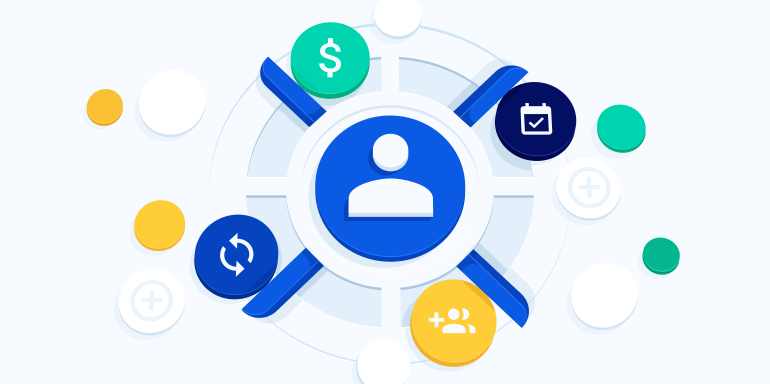- Marketing processes to automate
- Defining automation
- Defining the customer lifecycle
- Step 1: Define your marketing funnel
- Step 2: Track the right metrics
- Step 3: Map the customer journeys
- Step 4: Implement and automate
- Ways to automate digital advertising
- How to automate the post-click landing page
- How to automate email messaging
- Conclusion
Marketing automation is so ubiquitous today that you’re probably using software to automate one or more parts of your customer lifecycle without even labeling it automation.
According to a Social Media Today 2019 survey, 75% of marketers say they currently use at least one marketing automation tool in their business.
The top three processes that marketers find viable to automate without compromising on personalized experiences and reducing the overall effectiveness of their campaigns are:
- social media post scheduling
- email marketing (segmentation and automated messages)
- social media advertising (retargeting)
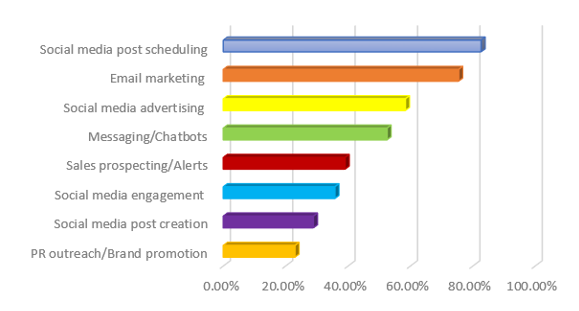
It’s not surprising that automation is widely accepted among marketers. Business owners, executives, and marketers asked to identify the biggest benefit of marketing automation for them, say it is saving time, followed by lead generation, and an increase in revenue:
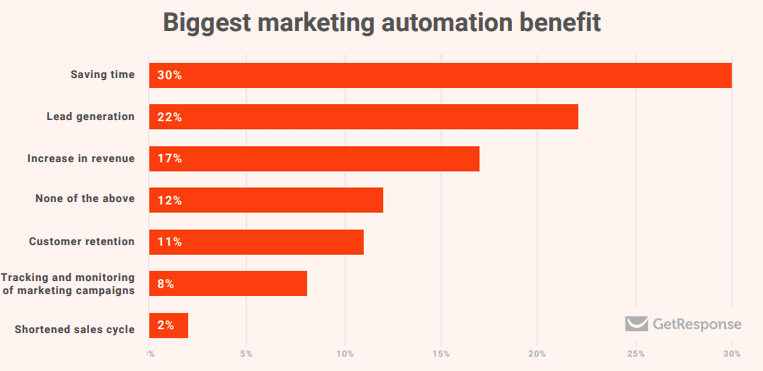
Still, some marketers state that creating effective automations and producing high-quality content to satisfy audience’s needs are among the biggest challenges they experience with automated processes.
The benefits of automating your business are obvious. At the same time, designing and implementing a complete strategy that automates your entire customer lifecycle is a complex project that requires strategic leadership, excellent cross-team communication, and in-depth technical know-how.
To guide you in this process and make things simpler and more actionable, below is a step-by-step framework that you can use to plan the automation of your customer lifecycle.
Before we go further, let’s explain a few terms.
What is automation exactly?
In its broadest sense, automation makes manual processes more efficient and allows newer processes to be implemented.
When it comes to digital marketing, automation helps you deliver highly targeted and personalized experiences and messages across different channels — digital ads, post-click landing pages, emails, and so on. Automation allows you to scale processes that would have otherwise been performed manually to attract and convert more customers.
What is the customer lifecycle?
The customer lifecycle describes the different stages a buyer goes through before, during, and after they purchase your business. It’s the process your customers experience when building relationships with your business. From the very first interaction with an ad campaign, through the post-click landing page experience, then the targeted lead nurturing email messages, and finally the process of becoming a paying customer and a loyal advocate — the lifecycle encompasses every customer touchpoint and interaction with your brand.
It’s important to note that this process never truly ends. The goal is to convert more users and leads into customers and to build strong loyalty so that your customers become advocates of your brand.
To achieve this, you must ensure that you have an effective marketing automation strategy that delivers personalized marketing communication across each stage of the customer lifecycle.
A step-by-step framework to automate your customer lifecycle
Step 1: Define your marketing funnel
It’s difficult to automate your marketing processes if you don’t know what exactly your customer lifecycle is. So, before evaluating any automation tools and the requirements to make them work together, you must get a bird’s-eye view of your business.
To define and map out your customer lifecycle, you must decide on a specific marketing funnel.
The marketing and sales funnel is the exact process a person takes towards becoming a customer and an advocate of your business broken down into specific stages. As customers move from stage to stage, some of them will leave the funnel while others will reach the end by becoming a loyal customer that refers more business to you.
There are plenty of funnels commonly adopted by high-tech businesses, to name a few:
- AIDA (Awareness, Interest, Desire, Action)
- AICA (Awareness, Interest, Consideration, Action)
- AARRR (Acquisition, Activation, Retention, Referral, Revenue – Dave McClure’s model from 500 Startups)
Instead of proposing a specific funnel, consider your business model and map the stages that are related to how your customers interact and buy from your organization.
To do that, you can use a spreadsheet or a simple table and visualize each stage of the funnel across one row:

With your lifecycle visualized, you could now decide what stage you want to automate. In a perfect case scenario, you would automate each stage. In practice, that could take months and a significant effort from your team. Therefore, it’s best to start with just one stage — usually, the one that you believe will benefit the most from automation.
Step 2: Track the right metrics
Everyone has data, but it’s important to figure out what pieces will improve your decision making and, ultimately, the bottom line of your business.
At this step, you need to decide the exact metrics that are specific, measurable, actionable, and relevant, so you can track how well your automation efforts are performing. Then, list these metrics in your automation strategy sheet.
When evaluating automation tools, go with the product that conveys value and displays the ideal state. Showing ads, creating dedicated landing pages, and sending emails is not the goal of your automation. Converting more customers and moving them down your funnel is.
In Instapage, for example, your Postclick Score™ is the percentage of unique experiences you have compared to the quantity of Ad Groups + Ads you have:
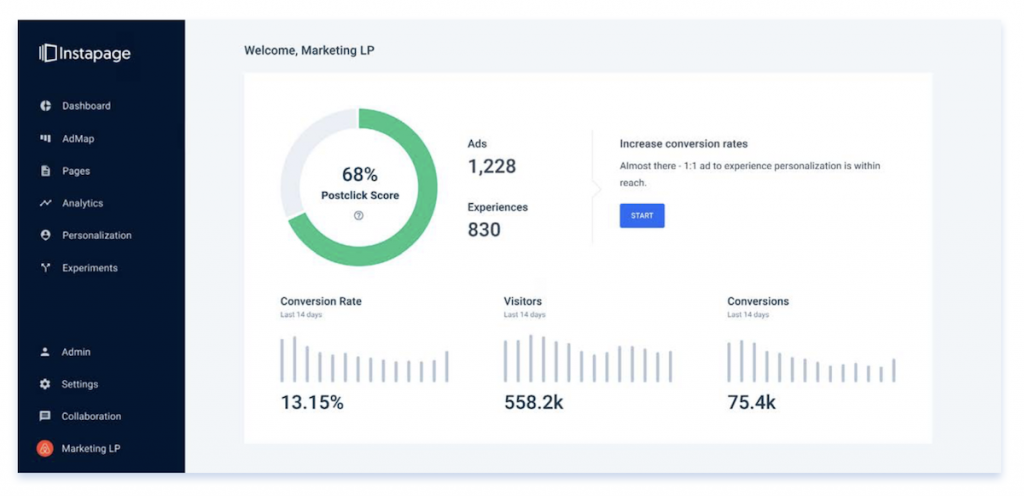
This dashboard lets you know at a high level, how many unique post-click pages you have connected to your Google Ads campaigns. The higher the percentage, the better. Here, the goal is to achieve 1:1 ad-to-page personalization.
Step 3: Map the customer journeys/scenarios
In this step, you must put yourself in your customer’s mindset and map the customer journeys that relate to each funnel stage. As SurveyMonkey explains,
The customer journey is the complete sum of experiences that customers go through when interacting with your company and brand. Instead of looking at just a part of a transaction or experience, the customer journey documents the full experience of being a customer.
While the marketing funnel visualizes different stages of the customer lifecycle like Awareness, Interest, Desire; the customer journey is a specific scenario or set of scenarios that a customer goes through that shows how the customer interacts with your brand on a touchpoint-by-touchpoint basis. It outlines the “story” of your customer’s experience from the client’s point of view.
For example:
- Your potential customer is searching for “Black Friday” deals and sees your ad on the Google search results page.
- She clicks your ad (because you’ve used ad customizers to increase your conversions!)
- She’s taken to a personalized landing page where you capture her email using a gated asset.
- Minutes later, your marketing automation software sends her the first email in your Black Friday sequence of emails with exclusive discounts and promotions.
- She is taken back to your website where her journey continues until she makes a purchase and later refers more people to your brand:
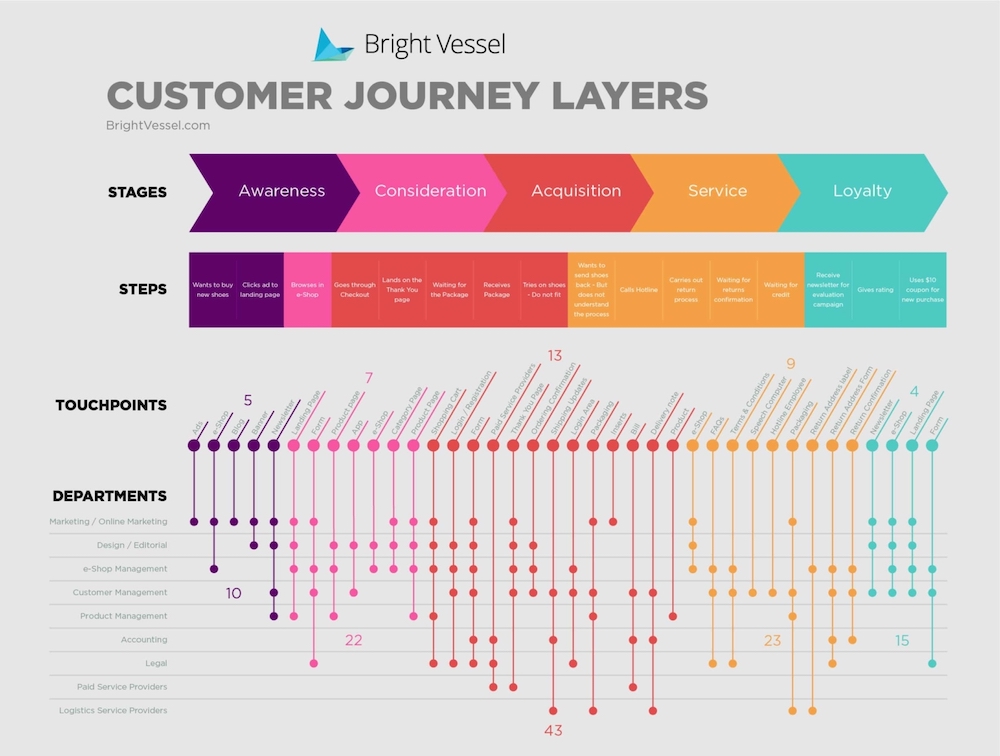
Outline the customer journeys granularly, and you will have an accurate picture of what you need to automate. That makes your plan easier and more actionable to implement.
Step 4: Implement and automate
With the first three steps completed, it’s time to put everything to work and make your automations live in your tool(s) of choice.
When evaluating automation vendors, there are two general strategies or philosophies: all-in-one vs. best-in-breed tools. On the one hand, you have all-in-one platforms like HubSpot and Pardot. On the other, you can operate with the best tools that cater to a specific fragment of the automation, like Instapage — the world’s first Post-Click Automation solution, or Encharge — a marketing automation platform built for product companies.
Whichever approach you proceed with, make sure the features provided by the software are aligned with the stages of your funnel and the customer journey scenarios that you want to automate. The goal of the tools is to help you improve on the key metrics that you set to track and measure in your strategy spreadsheet. So before implementing, ask yourself — is this automation going to help us move the person to the next stage of the funnel and increase our KPIs?
Aspects of the lifecycle to automate
Digital advertising
Advertising automation can help you streamline your lead generation efforts, lead scoring, customer lifecycle, and more. It is essential when a business begins to grow, and ineffective manual processes lead to irrelevant targeting segments and impersonal ad messages.
Advertising networks like Google Ads and Facebook have already allowed advertisers to use automated bidding strategies that aim to maximize clicks, increase visibility, conversions, and ultimately return on ad spend.
Apart from automated bidding, these platforms provide capabilities that allow for the automation of your ad content. For example, Google Ads lets create up to 15 headlines and 4 descriptions (below). The platform then creates combinations of the headlines and descriptions and tests for the best results automatically:
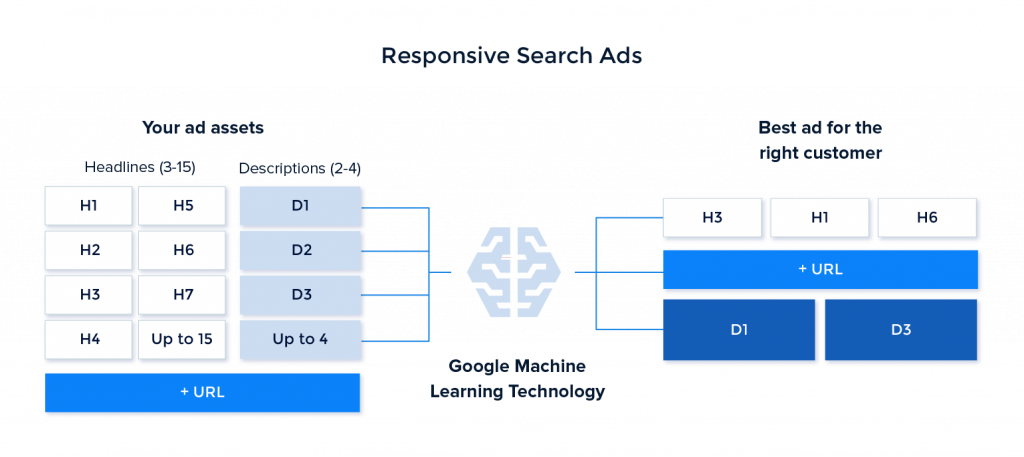
The post-click landing page
Post-click automation (PCA) enables marketers to maximize advertising conversions by automating the post-click stage in the marketing funnel. This is accomplished by delivering 1:1 personalized experiences at scale.
Your ads and the post-click landing page content (headlines, subheadlines, branding colors, etc.) must convey the same message:
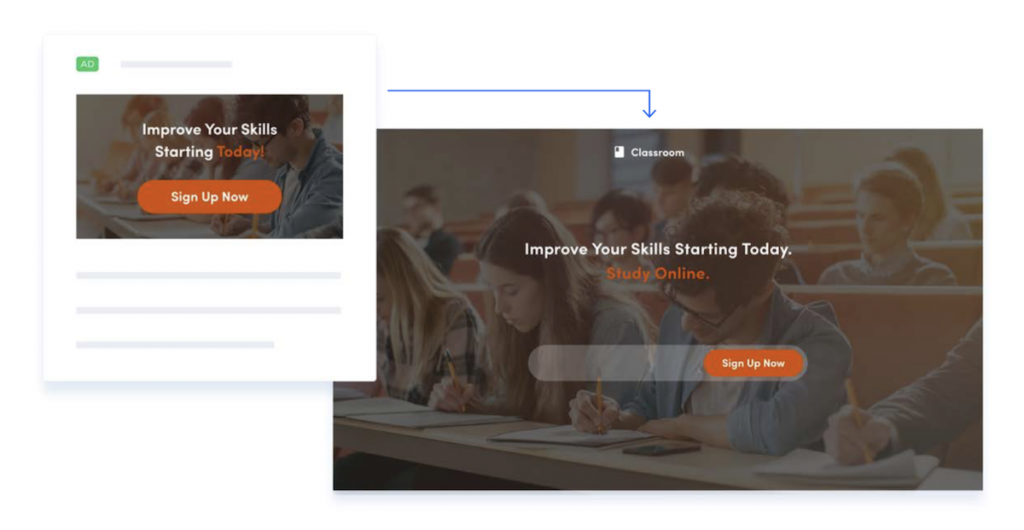
By automating your post-click landing page, you unify efforts across different technologies into a streamlined flow of initiatives focused on one stage in the funnel — converting ad clicks into conversions.
Customer email messaging
When it comes to software products, it takes about 40 days to get 80% of conversions. Moreover, half of SaaS conversions happen after the trial ends. In other words, you must create a highly personalized customer experience that goes beyond the landing page and the first conversion.
A targeted and personalized email can do something your site can’t — get users where they are and pull them back into your product. It can also encourage them to upgrade their accounts, help them adopt new features, or re-engage cold leads.
Off-site automation across the whole customer lifecycle is usually hard to implement. Marketing apps create data silos and make it difficult to unify experiences across the funnel. Fortunately, apps like Instapage and Encharge make it easy to unify and use up-to-date customer data to create personalized experiences across the full lifecycle.
In the example Encharge flow below, when a lead submits a form in Instapage, they receive an automated email sequence if the submitted budget is less than $5,000 or is added as a lead in HubSpot where a sales rep can follow-up with them manually if the budget exceeds that amount:
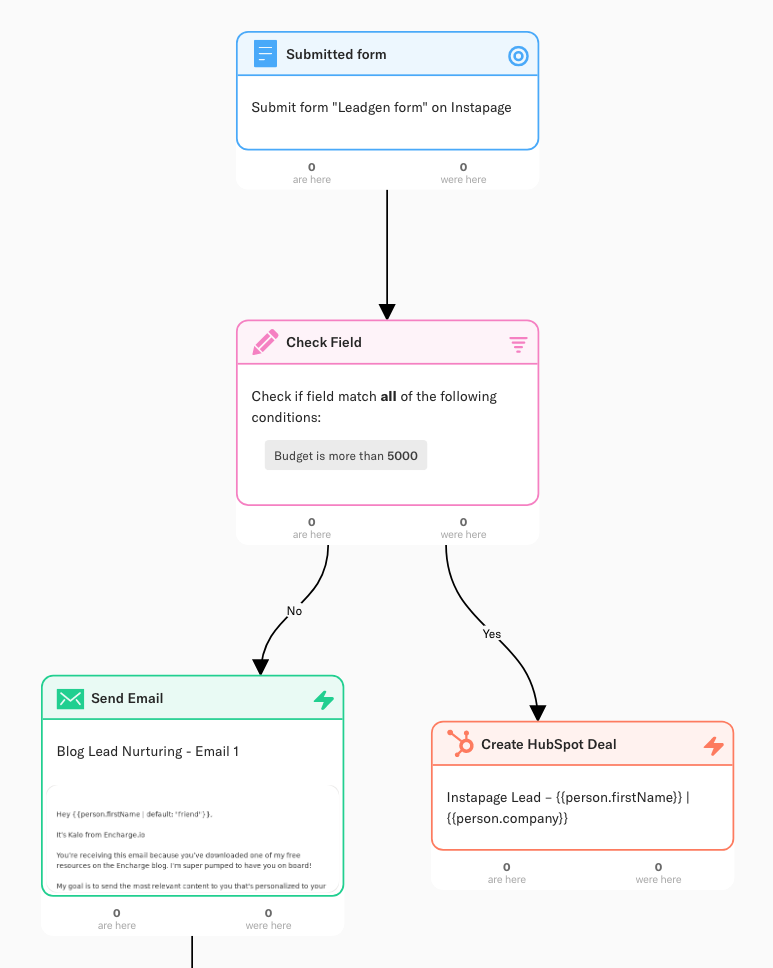
Conclusion
Automating your whole customer lifecycle is an intimidating task for CMOs and marketers alike. But once you map out the big picture and understand your funnel and customer journeys, it’s not too difficult to implement automation.
Start with the top-level strategy, then go deeper into the marketing stack that you need to roll out that strategy.

See the Instapage Enterprise Plan in Action.
Demo includes AdMap™, Personalization, AMP,
Global Blocks, heatmaps & more.
